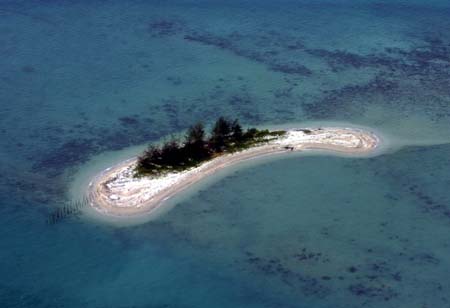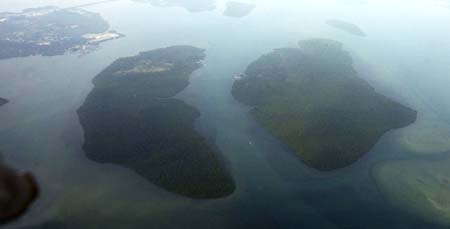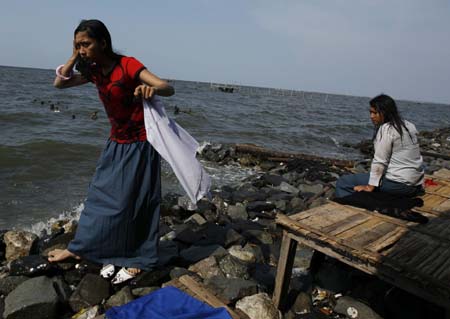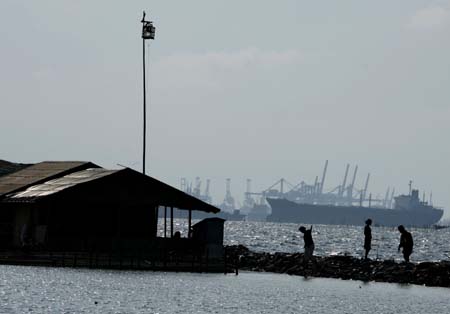Many of Indonesia's islands may be swallowed up by the sea if world leaders fail to find a way to halt rising sea levels at this week's climate change conference on the resort island of Bali.
Doomsters take this dire warning by Indonesian scientists a step further and predict that by 2035, the Indonesian capital's airport will be flooded by sea water and rendered useless; and by 2080, the tide will be lapping at the steps of Jakarta's imposing Dutch-era Presidential palace which sits 10 km inland (about 6 miles).
An aerial view of an unnamed Indonesian island in Riau province October 6, 2007. Many of Indonesia's islands may be swallowed up by the sea if world leaders fail to find a way to halt rising sea levels at a climate change conference on the resort island of Bali. The Bali conference from December 3-14 is aimed at finding a successor to the Kyoto Protocol, which expires in 2012, on cutting climate warming carbon emissions. [Agencies]
The Bali conference is aimed at finding a successor to the Kyoto Protocol, which expires in 2012, on cutting climate warming carbon emissions. With over 17,000 islands, many at risk of being washed away, Indonesians are anxious to see an agreement reached and quickly implemented that will keep rising seas at bay.
Just last week, tides burst through sea walls, cutting a key road to Jakarta's international airport until officials were able to reinforce coastal barricades.
"Island states are very vulnerable to sea level rise and very vulnerable to storms. Indonesia ... is particularly vulnerable," Nicholas Stern, author of an acclaimed report on climate change, said on a visit to Jakarta earlier this year.
Even large islands are at risk as global warming might shrink their land mass, forcing coastal communities out of their homes and depriving millions of a livelihood.
The island worst hit would be Java, which accounts for more than half of Indonesia's 226 million people. Here rising sea levels would swamp three of the island's biggest cities near the coast -- Jakarta, Surabaya and Semarang -- destroying industrial plants and infrastructure.
"Tens of millions of people would have to move out of their homes. There is no way this will happen without conflict," Environment Minister Rachmat Witoelar said recently.
"The cost would be very high. Imagine, it's not just about building better infrastructure, but we'd have to relocate people and change the way people live," added Witoelar, who has said that Indonesia could lose 2,000 of its islands by 2030 if sea levels continue to rise.
Indonesian girls walk along Marunda beach in Jakarta November 30, 2007. If world leaders fail to agree at a summit in Bali this week to an agreement that halts rising sea levels due to global warming, many of Indonesia's islands will be wiped out completely. [Agencies]
Crunch Time At Bali
Environmentalists say this week's climate change meeting in Bali will be crunch time for threatened coastlines and islands as delegates from nearly 190 countries meet to hammer out a new treaty on global warming.
Several small island nations including Singapore, Fiji, Kiribati, Tuvalu and Caribbean countries have raised the alarm over rising sea levels which could wipe them off the map.
The Maldives, a cluster of 1,200 islands renowned for its luxury resorts, has asked the international community to address climate change so it does not sink into a watery grave.
According to a UN climate report, temperatures are likely to rise by between 1.1 and 6.4 degrees Celsius (2.0 and 11.5 degrees Fahrenheit) and sea levels by between 18 cm and 59 cm (seven and 23 inches) this century.
Under current greenhouse gas emission levels, Indonesia could lose about 400,000 sq km of land mass by 2080, including about 10 percent of Papua, and 5 percent of both Java and Sumatra on the northern coastlines, said Armi Susandi, a meteorologist at the Bandung Institute of Technology..
Indonesia, the world's fourth-most populous country, has faced intense pressure over agricultural land for decades.
Susandi, who has researched the impact of climate change on Indonesia, estimated sea levels would rise by an average of 0.5 cm a year until 2080, while the submersion rate in Jakarta, which lies just above sea level, would be higher at 0.87 cm a year.
A study by the UK-based International Institute for Economy and Development (IIED) said at least 8 out of 92 of the outermost small islands that make up the country's borders are vulnerable.
Too Many Islands to Count
Less than half of Indonesia's islands are inhabited and many are not even named. Now, the authorities are hastily counting the coral-fringed islands before it is too late.
Disappearing islands and coastlines would not only change the Indonesian map, but could also restrict access to mineral resources situated in the most vulnerable spots, Susandi said.
He estimates that land loss alone would cost Indonesia 5 percent of its GDP without taking into account the loss of property and livelihood as millions migrate from low-lying coastlines to cities and towns on higher ground.
There are 42 million people in Indonesia living in areas less than 10 meters above the average sea level, who could be acutely affected by rising sea levels, the IIED study showed.
A separate study by the United Nations Environment Programme in 1992 showed in two districts in Java alone, rising waters could deprive more than 81,000 farmers of their rice fields or prawn and fish ponds, while 43,000 farm labourers would lose their job.
One solution is to cover Indonesia's fragile beaches with mangroves, the first line of defence against sea level rise, which can break big waves and hold back soil and silt that damage coral reefs.
A more expensive alternative is to erect multiple concrete walls on the coastlines, as the United States has done to break the tropical storms that hit its coast, Susandi said.
Some areas, including the northern shores of Jakarta, are already fitted with concrete sea barriers, but they are often damaged or too low to block rising waters and big waves such as the ones that hit Jakarta in November.
"It will be like permanent flooding," Susandi said. "By 2050, about 24 percent of Jakarta will disappear," possibly even forcing the capital to move to Bandung, a hill city 180 km east of Jakarta.
(China Daily via Agencies December 4, 2007)









